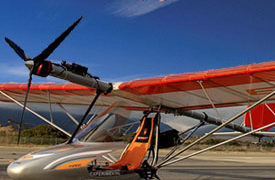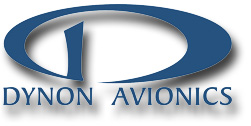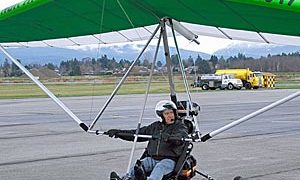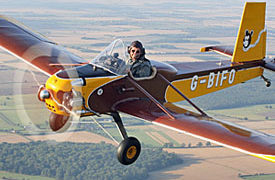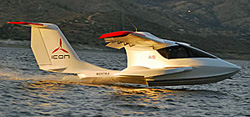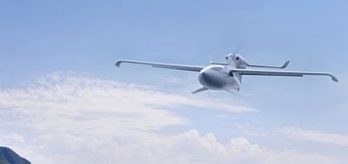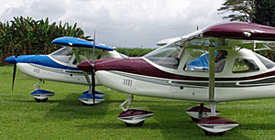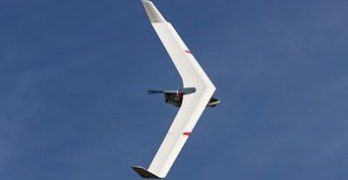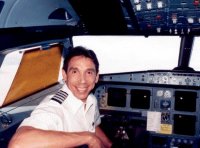Once upon a time the light aircraft industry announced new manufacturers and models at the rate of two, three, or even more every month …for several years. As with every maturing industry before, this torrid pace had to slow. Yet the party isn’t over, far from it. Contrarily, I am aware of several new projects in the works and we all know of some (Icon, Terrafugia, Lisa among others) where companies have been working on their designs for some years but they have yet to secure FAA approval as a Light-Sport Aircraft. Neither has GreenWing International, a new company announced this week though that may change quickly enough.
“Yuneec International, a world leader in electric power systems, is proud to announce the formation of GreenWing International, [which is] entirely focused on bringing the revolution of electric power to the global general aviation market,” announced company CEO Tian Yu. Enthusiasts following electric powered aircraft development first saw Yuneec’s e430 at AirVenture 2009.
Search Results for : Revo
Not finding exactly what you expected? Try our advanced search option.
Select a manufacturer to go straight to all our content about that manufacturer.
Select an aircraft model to go straight to all our content about that model.
Dynon SkyView Class Before Sebring Expo 2012
Our group was overwhelmingly instrument-rated pilots, not a flock of fresh students taking basic flight classes. Here were many experienced pilots paying rapt attention to a delivery by Kirk Kleinholz as he launched a series of classes covering the operation of the Dynon SkyView. *** In a few days, Kirk will repeat this several times via twice-daily classes offered at the Sebring Expo. Sebring sessions are free, though later classes may carry some tuition. *** Kirk needed to be highly knowledgeable with the Spruce Creek Fly-in group, and he is. A CFI-Instrument, he’s an expert on Dynon’s glass screens and matching SkyView to the mission. *** SkyView is a computerized EFIS (Electronic Flight Information System) offered in 7- or 10-inch sizes that display synthetic vision, moving map, and engine info.*** Kirk’s two-overhead-screen projection system allowed us to see his points while also viewing the effect of adjustments on a master SkyView unit that was linked to Dynon’s modestly-priced autopilot servos ($750 each).
Canada’s First Electric-Powered Ultralight
From the land of sky-blue waters comes … no, not a beverage but Canada’s first electric ultralight. And sky-blue waters aren’t the point; instead, it’s all about blue skies and getting up to them for a bit of soaring fun. Thanks to my journalist friend Russ Niles, Editor-in-Chief of AvWeb (one of my favorite aviation websites), I heard about a Canadian friend who’s done some interesting development work. Given the general excitement about electric power and my personal interest in soaring flight, I called up my old friend.
Like many of us who enjoy soaring hang gliders, developer Randy Rauck said, “I always wanted to apply electric to a lightweight trike so we could quickly and easily fly our hang gliders up to where the thermals abound.” When he’s not creating a new powerplant Randy runs the Freedom Flight Park in Lumby, BC Canada. “I wanted to try electric to get away from the vibration of a lightweight two-stroke gasoline engine.
Finding Answers in the Air — Lightening Your Mood
After my post about ups and downs with government and recreational aviation, it’s wise to keep perspective on the sheer joy that flying can deliver. Here’s Brit’ Dave Unwin’s take…
Why fly? I was thinking this just the other day while wading through three piles of unpleasant-looking paperwork. One pile contained reminders regarding renewal of my medical, BFR and BGA BI ratings, another had info on my VP-1’s Permit renewal and insurance while the third, and largest, held news which I planned to refer to while writing ny monthly magazine column called “Push to Talk.” The news was all pretty grim — airfields closing and fuel prices rising, EASA, airspace grabs, the outrageous proposals for the Olympics, Mode S, ad nauseum. Bored (and slightly depressed) I did the only sensible thing — I went flying.
It was a beautiful evening and my demeanor was improving exponentially as I approached the airstrip.
Volkswagen for Drivers; Volksplane for Pilots
Barely had we published the announcement of Dave Unwin as a new ByDanJohnson.com contributor but what two visitors wrote asking for a review of Dave’s affordable VP-1. We’re pleased to answer that request quickly. Enjoy…! |||| Far below the sun-splashed wings the autumn shadows are lengthening across the Lincolnshire Wolds. Sunset won’t be long, and I’ve still got around 40 nm to go. Thank goodness I’ve got a tailwind, for although the Evans VP-1 Volksplane is many things, one thing it isn’t… is fast! *** So, how does it fly? Well, with only 60 hp the acceleration is far from startling, and it is important to pick up the tail, particularly if the grass is long as the tailwheel is small. Fortunately the large stabilator becomes effective quickly, as does the rudder. No problem keeping her straight. However, VP-1 is hardly over-powered; you must “fly the wing.” You don’t quite have to coax it into the air, but you can’t bully it either.
Beauty and the Bird — Do Esthetics Matter?
Even those who are not Apple fans agree the trend-setting California company’s focus on design beauty draws attention to their products. From their position near the back of the pack a dozen years ago, Apple has become the most valuable tech company in the world. Could this be due to their highly-refined sense of esthetics? More to the point of aviation enthusiasts, is artful design an ingredient in pleasing customers? *** I don’t know what all buyers are thinking but beauty has long enhanced the appeal of most consumer products. It seems the so-called niche aircraft producers have gotten this message perfectly well. Especially this is true for those products that have emerged since Light-Sport Aircraft burst upon the aviation scene. *** Creators of new LSA seaplane designs in particular seemed to have found the religion of design esthetics. Icon leads the pack with their stunning — and extremely well presented — A5.
Three If By Sea
Some bright minds at LISA Airplanes, a French company, had a great idea to take the hydrofoil concept and apply it to an LSA seaplane. I’d often wondered why hydrofoils haven’t been done before, it’s such a great concept.Anyway, the airplane is the AKOYA. The technology for the entire package is patented and called Multi-Access, not the most sizzling name but what the hey, look at how cool those little moustache water wings look sticking out from the hull! *** Now get this: the company claims AKOYA operates as easily from land as from water…or snow! First, to those water wings sticking out: they’re called Seafoils, a trademarked name, which adds a little more marketing sizzle to this steak. *** They’re connected to a retractable gear that can be rigged with wheels or skis, I guess, and also to motor-driven, pivoting wings! There’s also a chute onboard. Very neat.
Fixed wing or Flexwing; Take Your Pick
I am only aware of one company* in the USA that offers you a choice of a conventional three-axis fixed wing or a weight-shift control (WSC) flexwing. Why do this? Simple. Not all pilots want the same kind of aircraft and some of us like both kinds of flying.
It happens that the boys from Zephyr Hills airport have two interesting machines and you ought to know about them. “Boys” in this case refers to Abid Farooqui, Larry Mednick, and Phil Mednick; the latter are a son and father combo. Abid and Larry are trike guys while Phil is the fixed wing fellow and they display not only expertise, but as the impressive Revo development shows, they bring genuine creativity to the aircraft. This trio of talent operates several businesses, including a flight school.
One company, Apollo Aircraft, offers the Columbian-designed Ibis Magic as well as the Apollo LSA (formerly Apollo Fox).
Electric Flight: More Thoughts
Yesterday a reader commented on my electric flight post, specifically about the LZ FES, a pretty sexy add-on that just won the Lindbergh LEAP prize for best new electric propulsion system. He wondered whether electric flight for now required light weight motorgliders or whether heavier, 15M plus sailplanes/motorgliders would be workable for electric power. *** My answer began to get too lengthy to stick in comments so I’m posting it here, and thanks Thomas for your enthusiasm. *** I talked over this very subject this week with Randall Fishman, the award-winning electric flight pioneer. His take on where we’re at right now is in my Profiles in Vision column, coming in the July issue of P&P. *** Randall’s whole trip is to get people up in the air with electric power right now, and not for 150,000 clams either. To summarize his own one-man research and development plan, it’s all about lightweight motorgliders.
Larry Newman, 2011
Larry Newman, 63, one of the seminal manufacturing/marketing dynamos in the early days of hang gliding who made the successful transition to ultralights, has died after a reported 3-year battle with pancreatic cancer. *** Larry was a flamboyant entrepreneur who successfully sold his ElectraFlyer hang gliders. *** When people started sticking motors on the foot launched craft, he came out with a new company, American Aerolites, to produce the Eagle ultralight. *** I first flew the Eagle with Plane & Pilot Publisher Steve Werner back in 1983. I remember it vividly: while Steve was up on a test hop, I was taking photos of his flight next to the runway at Coronado Airport, north of Albuquerque, near Larry’s factory…and I got stung twice by fire ants.I almost jumped out of my jeans, it hurt so bad. I thought I’d been shot in the leg. I could barely see the critters but what a painful wallop they packed.
- « Previous Page
- 1
- …
- 8
- 9
- 10
- 11
- 12
- …
- 15
- Next Page »


